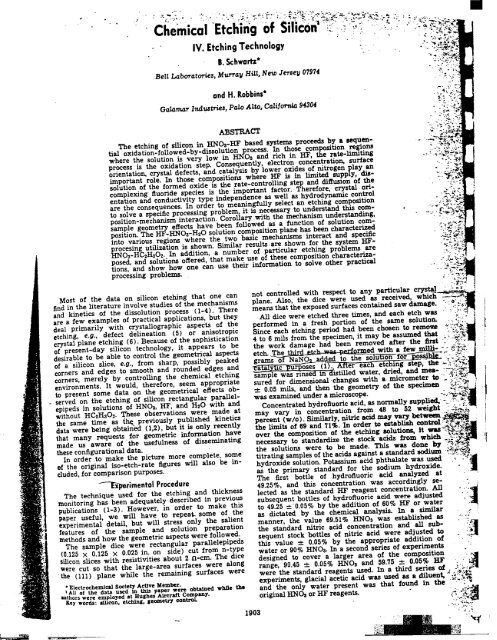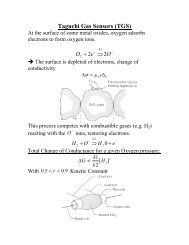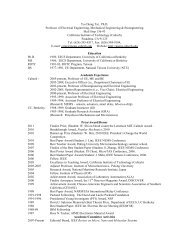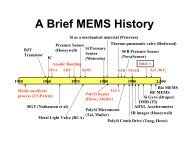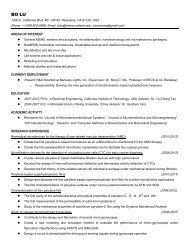02-a Wet etching - Caltech Micromachining Laboratory
02-a Wet etching - Caltech Micromachining Laboratory
02-a Wet etching - Caltech Micromachining Laboratory
Create successful ePaper yourself
Turn your PDF publications into a flip-book with our unique Google optimized e-Paper software.
, '., ...: Chemical ""~.:.:::'; ~ :'- ',...~;."': Etchin'g ,.;.~.-;:':..:-f.:. of ;:,~~~;~~~.-:..:i~~~:~.:::=~-~;;.;',::'-~:~,;'-:~:;.~ Silicon ..::~-'.. -~ ~..,;. --',~.: ~ ~.; ;..,.::::~~?~~~~~.<br />
, ; ."<br />
..-, -.; '-:-,,"':<br />
IV. Etching Technology ...'- ~:~Z~",<br />
.":, ~::'"~Z~tJ<br />
B, Schwartz _:".~.'~~".."(.<br />
..' ...<br />
Bell Laboratories, Murrau Hill, New JerBe'j 07974 :;';;'-:~.{~<br />
d H R bb ' .--; --<br />
an ,0 Ins:.~;'" i'~:<br />
:1'. .;<br />
Galamar Industries, Palo Alto, California 94304 .-',~ :.:";-:<br />
ABSTRACT<br />
, .-"."<br />
-.;"~.::; ~;<br />
.:~::;~k;;<br />
The <strong>etching</strong> of silicon in HNOa-HF based systems proceeds by a sequ.en- --.~ :,.-#~~~.<br />
tial oxidation-fo.11o",:ed-by-dissol~tion process. ~ ~ose composition ~~~ns 7 .:.~~;:.~::;;:':<br />
where the solution 15 very low m HNOa and nch m HF, the rate-limiting .' .: ~'~~.<br />
process .is the oxidation step. Conseq~ently, electro~ concen~ration, surface '- ~-~: ~t'<br />
,?rientatlon, crystal defects, and c~t,alYSIS by lower I?Xl.des ~f .nItrogen play .an -;::;.:1,<br />
lInportant role. In those composItIons where ~ 15 m 1imi~ su?ply, dis- :..~~"'-<br />
solution of the formed oxide is the rate-contro11mg step and diffusIon of the .::;.~.:<br />
complexing fluoride species is the important factor. Therefore, cr,:stal ori- :::.::<br />
entation and conductivity type independ.ence as well as hydrodynan1lc co~t;rol -);.;~,;'..<br />
are the consequences. In order to mearongfully select an <strong>etching</strong> COmI;>oSltlon ,; :'"-' --f:,<br />
to solve a specific processing problem, it is necessary to un.derstand this CO;m- .--""t.:-~~-:~<br />
position-mechanism interaction. Corollary with the mec~m under.standing, -,.; -.;.:~:~'~)J<br />
sample geometry effects have be~n follow~ .as a functIon of solution c«;,m- ., -;'.".;;<br />
position. The HF-HNO3-H20 solution coml?osltion pl~e h~ been characte~ '.::OJ:.[~:<br />
into various regions where the two haslC mechanlSms mteract and specific ,:,::;:'d:;~<br />
procesing utilization is shown. Similar results a~ shown fo~ the system HF- .:~..;.:i<br />
HNOa-HC2H3<strong>02</strong>. In addition, a number of particular <strong>etching</strong> problems .are ::!;':",,?<br />
posed, and solutions offered, that make. u~e of the~e composition characterl;U- :..,: ~'._~:. '.<br />
tions, a.nd show how one can use theIr Information to solve other practical .'. :.~-~~-;~<br />
processIng problems. ~';'"<br />
..-:. .,.,<br />
, ...~i:;,;j: i<br />
Most of the data on silicon <strong>etching</strong> that one can not controlled with respect to any partic.war c~ :-::~~:i, 1<br />
~<br />
find and kinetics the literature of the involve dissolution studies process of the (1-4). mechanisms There plane. means that Also, the the exposed dice were surfaces used contamed as. receIved, saw damage. which :-:',:;i-" :'~~.~:-!-"<br />
are a few examples of practical applications, but they All dice were etched three times, and each etch was ' -;.'. :--/<br />
deal primarily with crystallographic aspects of the performed in a fresh portion of the same solution. '-.. ;~;:<br />
<strong>etching</strong>, e.g., defect delineation (5) or anisotropic Since each <strong>etching</strong> period had been chosen to remov~ :.:::-::-1,;<br />
crystal plane <strong>etching</strong> (6). Because of the sophistication 4 to 6 mils from the specimen, it may be assumed that ;.; ~l::~<br />
of present-day silicon technology, it appears to be the work damage had been removed after the first : _.:~.::<br />
desirable to be able to control the geometrical aspects etch. The third--.etch-was p~rformed with a few ~:-- .~:.t-,=~of<br />
a silicon slice, e.g., from sharp, possibly peaked gramss=~ NaNQ;2~tO the ~~ssi-PJL ':-:.,:;'f;..,<br />
corners and edges to smooth and rounded edges and a lC u oses (1). er eac <strong>etching</strong> step, the '-:~'.~~~:;'.;,<br />
corners, merely by controlling the chemical <strong>etching</strong> sample was rins m istilled water, dried, and mea- .._",::;.::..~..<br />
environments. It would, therefore, seem appropriate sured for dimensional changes with a micrometer to '- ,~ ~:,~<br />
to present some d~ta on t,h.e geometrical effects ob- :t. 0.05 ~s, and then ~e geometry of the specimen -~J~;~ . '<br />
-served on the etchIng of silicon rectangular parallel- was exammed under a IDlcroscope. -~.:, ,O;i:,:.;<br />
e~ipeds in solutions of HNOa, HF,. and H2O with and Concentra~ed hydrofluoric acid, as normally SUPP1!ed. .:... "~-.~; ,<br />
without H~2H3<strong>02</strong>. 'I;'hese ob~ervatlons ~ere m~de ,at may vary m concentration from 48 to 52 weIght :~':'-':~"'~<br />
the same tiJ?e as t~ preVIously ~u~lished kinetics percent (w/o). SimnA1'ly, nitric acid may vary betwe81.~<br />
data were beIng obtain"ed (1,2), b';lt 1: 15 onlY,recently the limIts of 69 and 71%. In order to estab;1ish control~"iI!1<br />
that many requests for geometnc info~tio~ h~ve over the composition of the <strong>etching</strong> solutions, it was"':.:4=1'!~made<br />
us aware of the usefulness of disselDlnating necessary to standardize the stock -acids from which .;.~"'::~..<br />
these configurational data. the solutions were to be made, This was done by .~;f~<br />
In orde,!, ,to m.ake the picture more ~omplete, s°!De titrating samples of the acids against a standard sodium ;~:"~~:~1<br />
of the ongmal Is~-etch-rate figures will also be m- hydroxide solution. Potassium acid phthalate was used ;. .4<br />
cluded, for companson purposes, as the primary standard for the sodium hydroxide. .I<br />
~_. The bottle of hydrofluoric acid analyzed first at '<br />
p~<br />
Lxt'golmental Proced~re .49.25%, and this concentration was accordingly se- -;<br />
The technique used for the etchm~ an~ thlck~ess lected as the standard HF reagent concentration. All ..-<br />
monitoring has been adequatel~ descnbed m prevlo~s subsequent bottles of hydrofluoric acid were adjusted '.'"<br />
publications (1-3). However, m order to make thiS to 49.25 :t 0.05% by the addition of 60% HF or water.<br />
paper useful, we will have to repeat- some of. the as dictated by the chemical analysis, In a similar ."' ,<br />
experimental detail, but will stress only the sall~nt manner, the value 69.51 % HNOa was established as " '::.<br />
features of the sample and solution preparatIon the standard nitric acid concentration and all sub- .::':<br />
methods and h°v.: the geometric aspects were fo11o",:",ed. sequent stock bottles of nitric acid ~ere adj\,1s.ted to _:~ 1<br />
The sample dIce were rectangular parallelepIpeds this value :t. 0.05% by the appropnate addItIon of .<br />
~<br />
(0.125 X 0.125 X 0.<strong>02</strong>5 in. on side) cut from n-t~pe water or 90% HNOa. In a second series of experiments .<br />
silicon slices with resistivities about 2 {l-cm. The dice designed to cover a larger area of the composition . ~.<br />
were cut so that the large-area ~u,rfaces were along range, 90.45 :t. 0.05% HNOa and 59.75 :t 0.05% HF -.: j.<br />
the (111) plane while the remaInIng surfaces were were the standard reagents used. In a third series of .-~ '~':.f~<br />
.Electrochemical Society Active Member. experiments, glacial acetic acid was used as a ~uent, .:I.:~!~~_~i<br />
1 All of the daU used In this paper were obtained whfie the and the only water present was that found In the -.~<br />
authors were employed at Hughes Aircraft Company. original HNOs or HF reagents. ..;;.':-<br />
Key words: I1l1con, <strong>etching</strong>, geometry control. i' : =-"'( ,", ~<br />
1903 .'.":~';~,'~<br />
" ,.<br />
---,<br />
."c.~


